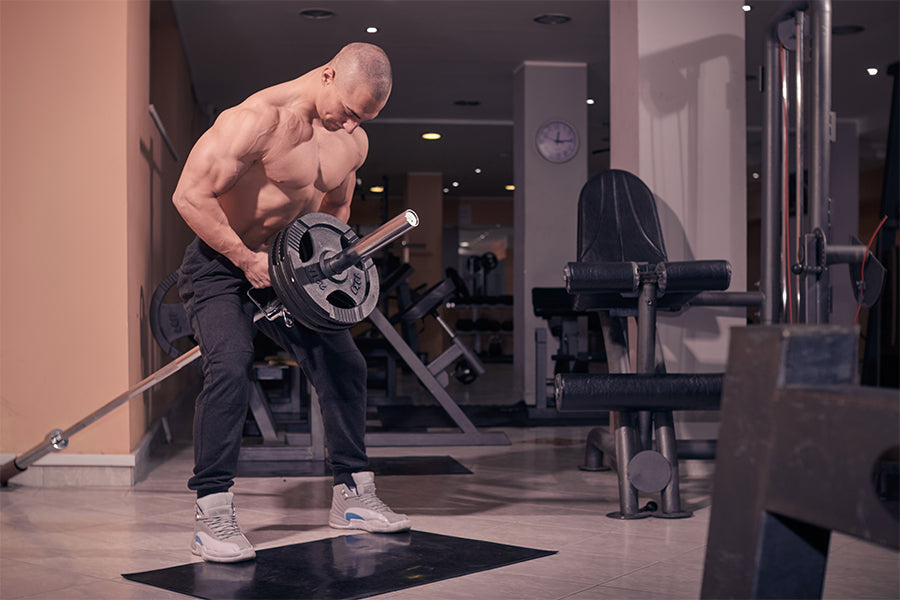The T-bar row is an excellent exercise for strengthening the back and core, improving posture and stability, and increasing overall upper body strength. This compound movement works for various muscle groups at once and can be performed using a loaded barbell or a specialized machine.
The T-bar row is an exercise suitable for intermediate to advanced gym-goers looking to build back strength.
This article will cover how to do a proper T-bar row, its benefits, variations, and the muscles worked.
Related Article: 5 Most Important Tips to Start Your Fitness Journey
How to Do the T-Bar Row?
The T-bar row is a great exercise that can strengthen your upper and middle back muscles, improve your posture, and help prevent injury.
Here's how to do the T-bar row correctly:
- Position yourself away from a loaded barbell, and set it up with an appropriate weight.
- Place one foot on either side of the barbell with your feet shoulder-width apart and toes pointing slightly outwards.
- Bend forward from the hips so that your body forms an angle of approximately 45 degrees relative to the floor.
- Support yourself using both hands on either side of the barbell near its center point.
- Pull the barbell towards your midsection to keep your chest up and spine aligned.
- Once your chest touches the barbell, slowly extend your arms to the starting position and repeat.
Benefits of T-Bar Rows
The t-bar row is a popular upper-back compound exercise. It can be done with either a t-bar machine or, as an alternative, using a barbell. The benefits of T-bar rows include the following:
Improved Posture
The T-bar row helps improve overall posture and spinal stability by strengthening the core and back muscles. This can help reduce lower back pain, which is often caused by poor posture or incorrect movement during exercise.
Increased Upper Body Strength
As mentioned above, the T-bar row is an effective compound exercise that works for multiple muscle groups at once, making it great for improving overall upper body strength and muscular definition.
Injury Prevention
Strengthening muscles in the middle of your back will also aid in preventing shoulder injuries. These muscles help keep your shoulders aligned when performing other exercises, such as overhead or bench presses.
Related Article: Injury Prevention: 7 Ways to Stay Injury-Free for Life
Variations of the T-Bar Row
By implementing these variations of the T-bar row into your routine, you can target different muscle groups and reap the full benefits of this exercise. Regardless of which variation you choose, be sure to perform each with the proper form to maximize its effectiveness and reduce the risk of injury.
With consistent practice and dedication, you will soon be able to develop strong back and upper body muscles. The variations of the T-bar row include the following:
Single-Arm Rows

Single-arm rows are a fantastic way to work your back muscles in a controlled and safe manner. It is an exercise that has been used for centuries to strengthen the back and increase stability. The single-arm row also offers a wide range of motion, allowing you to target specific muscle groups.
- To do the exercise, begin by holding one end of a loaded barbell with the palm facing towards you.
- With your feet shoulder-width apart and your knees slightly bent, pull the weight towards your hip while keeping your torso neutral.
- At the top of the movement, squeeze your back muscles before slowly releasing the weight back to its starting position.
Seated Rows

Seated rows are a foundational exercise for back strength and muscular development. The muscles worked during seated rows include the latissimus dorsi (lats), trapezius, rhomboid, biceps, forearms, and core stabilizers. In addition to effectively targeting these muscle groups, it is also beneficial in terms of developing strength and stability.
- To start, sit on a machine row.
- Engage your core as you lean forward and grab the handles with an overhand grip, ensuring that your palms are facing down and away from you.
- Slowly draw the handles towards you, squeezing your shoulder blades together and keeping the bar close to your body.
- Return the weight to its starting position for one complete repetition.
Pendlay Rows

This exercise targets the latissimus dorsi (lats), rhomboid, teres major, rear deltoids, and erector spinae. Pendlay rows can be done with a barbell or a pair of kettlebells. For those looking for even more intense exercise, Pendlay rows are a great option.
- This exercise begins with you hinging at the hips with the barbell on the ground.
- Grasp the barbell with an overhand grip (palms facing down) and lift the weight from its resting position straight towards your chest as you arch your back slightly.
- At the top of the movement, squeeze your shoulder blades together before slowly lowering the weight again.
- Make sure to keep tension in your arms throughout the entire movement.
How to Build a Massive Back With the T-Bar Row?
The T-bar row is great for building muscle mass in the back because it hits all of the major muscles in the area. It works your lats, traps, rhomboid, and stabilizers like your biceps and triceps.
This exercise's primary benefit is increased strength in the upper body region, improved posture, and reduced lower back pain due to an imbalance between shoulder and leg muscles.
To maximize results with this exercise, there are a few techniques that can be used:
- Use a wide grip – having your hands wider than shoulder-width creates more stretch on the lats, which helps build muscle.
- Keep your core tight – engaging your core helps you stabilize and maintain proper form during the exercise.
- Keep your elbows close to your body – this increases contraction in the lats, which is essential for gaining muscle mass.
- Pull the weight up explosively – this will help build power, increase strength, and maximize results.
FAQs
1. Which muscles are worked in the T-Bar row?
The major muscles worked by this exercise include the back extensors of the lower and middle back (the lats, rhomboid, trapezius) as well as core stabilizers such as the rectus abdominis and erector spinae. Secondary muscle groups, including the biceps, obliques, glutes, and hamstrings, are also engaged during this exercise.
2. What are the differences between the t-bar row and the barbell row?
The T-bar and barbell row are two of the most popular exercises for back training. They both target major muscle groups in the back but have some differences that make them unique.
The main difference between the two is that with a T-bar row, you can use more weight because weight is moving on an angle as opposed to the barbell row path, which is vertical.
The barbell row also can target slightly different muscles, such as the shoulder joint's rear delts and external rotators, which can help increase size and strength in those areas.
3. What muscles are worked during the bent-over row?
The bent-over row targets the back muscles. Specifically, it works the trapezius, latissimus dorsi, rhomboids, and erector spinae muscles. The shoulder and arm muscles, such as the biceps, triceps, and forearms, also work well.
Furthermore, stabilizer muscles such as the abdominals, obliques, and lower back are also worked to a lesser degree during this exercise. For this reason, the bent-over row is an excellent exercise for developing upper body strength and improving posture.
4. Do pull-ups and rows work the same muscles?
Although pull-ups and rows are both exercises that target the back muscles, they do not work the same muscles. The pull-up mainly targets the latissimus dorsi and biceps muscles, while the bent-over row primarily works the trapezius, rhomboids, and middle back muscles.
Moreover, each exercise's range of motion is different, meaning the muscles are activated differently. Therefore, both exercises should be included in any back-strengthening routine.
Conclusion:
T-bar rows offer numerous benefits for beginners as well as professionals. It is an effective way to improve posture by strengthening weak areas in the upper back while stretching out tight muscles in the front of the body. Furthermore, it can help enhance core stability, reduce the risk of injury, and improve performance.
Overall, implementing T-bar rows into your routine is an effective way to strengthen your upper back while improving your overall fitness and posture. To ensure you get the most from this exercise, use proper form and technique every time. It is also important to note that it should be paired with other exercises for a complete upper-body workout.











